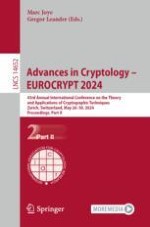
2024 | OriginalPaper | Buchkapitel
Anamorphic Encryption, Revisited
verfasst von : Fabio Banfi, Konstantin Gegier, Martin Hirt, Ueli Maurer, Guilherme Rito
Erschienen in: Advances in Cryptology – EUROCRYPT 2024
Verlag: Springer Nature Switzerland
Aktivieren Sie unsere intelligente Suche, um passende Fachinhalte oder Patente zu finden.
Wählen Sie Textabschnitte aus um mit Künstlicher Intelligenz passenden Patente zu finden. powered by
Markieren Sie Textabschnitte, um KI-gestützt weitere passende Inhalte zu finden. powered by